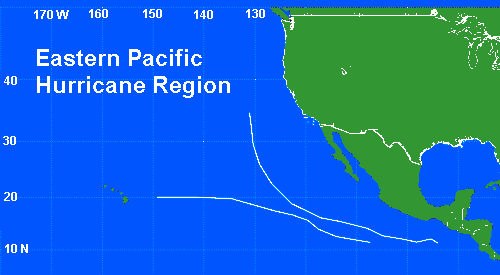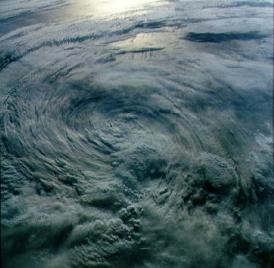 |
 |
| Home | Welcome | What's New | Site Map | Glossary | Weather Doctor Amazon Store | Book Store | Accolades | Email Us |
 | ||||||||||||||||||||||||||||||||||||||||||||||||||||||||||||||||
Weather Almanac for August 2003PACIFIC HURRICANES: THE FORGOTTEN STORMSWatching the North American media weather news over the past month, I have seen stories on the pre-season birth of Tropical Storm Ana, the flooding surrounding Tropical Storm Bill, the sudden, swift blow of Hurricane Claudette to Texas and the brief marine life of Hurricane Danny. I have heard about Typhoons Soudelor and Imbudo. But I do not recall even a mention of Tropical Storms Andres, Blanca, Carlos, Dolores, Enrique, or Felicia. To date (the fourth week of July), these latter tropical storms have formed, vented their fury and dissipated off the west coast of Mexico, the first batch of 2003 Eastern Pacific tropical storms/hurricanes. Eastern Pacific hurricanes are not well known nor their existence reported because most of them spend their lifetimes over the eastern and central Pacific Ocean far from land and heavy shipping lanes. And yet on average, more Eastern Pacific hurricanes form each year (8) than their Atlantic cousins (5). Sixteen tropical storms typically form in the Eastern Pacific each year (compared to 10 in the Atlantic). The greatest number of observed Eastern Pacific tropical storms in any single year has been 27 in 1992, with 16 of them reaching hurricane force. Sixteen Pacific hurricanes also formed in 1990 out of 21 tropical storms.
Eastern North Pacific tropical storms arise over the warm waters off the western Mexico and Central American coast from mid-May — the season "officially" starts on the 15th — through November, but the stormiest period generally falls from July through September (similar to the Atlantic season). Pacific hurricanes are designated Eastern Pacific hurricanes when they occur between the west coast of the Americas and longitude 140 degrees West. Those occurring between 140 and 180 degrees West (the International Date Line) are Central Pacific hurricanes. The designation is mostly due to a change in the forecast centre responsible for tracking and forecasting of the storms. The Eastern Pacific is under the jurisdiction of the National Hurricane Center office in Miami, Florida, while Central Pacific storms fall to the Central Pacific Hurricane Center in Honolulu, Hawaii. West of the Date Line, the hurricane designation changes to typhoon, and forecast/tracking responsibility falls to the US Joint Typhoon Warning Center and the Japan Meteorological Agency. Naming of tropical storms in the Northeast Pacific basin began using women's names in 1959 for storms near Hawaii, and in 1960 for the remainder of the Northeast Pacific basin. Since with the 1978 season, storms have been named using both men's and women's names. The names are a mix of English and Spanish origin in the Eastern Pacific Region and Hawaiian in the Central Pacific Region. Like Atlantic hurricanes, Eastern Pacific names are recycled every six years. In the Central Pacific Region, there are four lists of names and they are used sequentially. When the bottom of one list is reached, the next storm is named from the top of the next list. Storm Formation and TrackingPacific tropical storms require the same spawning conditions as their Atlantic brethren, most importantly, a large area of warm water above 26o Celsius (80o Fahrenheit) between ten and twenty-five degrees north of the equator. Many Pacific tropical storms form off the southwest coast of Mexico. Early-season Pacific hurricanes tend to drift westward into the open North Pacific, but as the season progresses, more hurricanes are steered northward parallelling the American Pacific Coast. Pacific hurricane seasons have been found to average above normal in number of storms during El Niño years and below normal during La Niña years, the opposite tendency found for Atlantic hurricanes.  Typical Storm Tracks in Eastern Pacific OceanFrom their birth-waters, Pacific hurricanes (a designation I'll use hereafter to refer to storms of tropical storm and hurricane intensity found in the eastern and central North Pacific Ocean) typically are steered by the tropical trade winds westward into the open ocean. Consequently, few hit land and those that do usually strike along the Mexican coast. Should a full-blown hurricane curl back toward the State of California, it must cross the cold California Current flowing southward along the coastline. The California Current's waters rarely exceed 15o Celsius (60o Fahrenheit) and quickly take the bit out of any hurricane crossing them. No hurricane has ever hit California, though a few tropical storms have. In September 1939, a tropical Pacific storm packing winds of 80 km/h (50 mph) struck the Los Angeles–Long Beach, California area. The storm produced 144 mm (5.66 inches) of rain at Los Angeles and 295 mm (11.6 inches) at Mount Wilson. The storm caused two million dollars damage, mostly to crops and coastal structures, and claimed 45 lives at sea. Most Central Pacific hurricanes also originate in the warm, tropical waters of the eastern Pacific and then move west-northwest. Every few years, a Pacific hurricane traverses the Pacific to worry Hawaiian Island residents, but most diminish before reaching the Islands because, again, the nearby waters generally remain too cool to sustain a hurricane's intensity. The last major hurricane to strike the Hawaiian Islands was Hurricane Iniki in September 1992, causing $1.8 billion dollars in damage to the Island of Kauai.  Hurricane Iniki, 1992 |
||||||||||||||||||||||||||||||||||||||||||||||||||||||||||||||||
|
Notable Pacific Hurricanes | ||
|
Name |
Date |
Remarks |
| Unnamed storm | 1957 October 21 |
Winds 130 mph in Mazatlan, Mexico before the anemometer blew away; Extensive damage to buildings; many boats sunk or beached; 8 people killed when Mazatlan's jail blew down. |
| Hurricane Dot | 1959 August 2 to 8 |
150 mph wind; no loss of life or serious injuries; $6 million property damage on Kauai. |
| Hurricane Katrina | 1967 August 31 to September 2 |
Winds and storm surge sink 60 vessels and partially destroy San Felipe, Mexico; 2,500 people homeless. |
| Hurricane Bridget | 1971 June 17 |
Gusts exceed 100 mph in Acapulco, Mexic;. Ten ships sink, including the flagship of the admiral of the Mexican Navy. Acapulco's worst storm in 25 years; estimated death toll: 40. |
| Hurricane Olivia | 1975 October 25 |
Winds exceed 100 mph; 30 dead and 30,000 people homeless in Mazatlan, Mexico. |
| Hurricane Liza | 1976 October 1 |
Heavy rain, winds to 130 mph; dam collapses on Mexico's Cajoncito River killing at least 630 people in La Paz. |
| Hurricane Iwa | 1982 November 19 to 24 |
Sustained winds 80-90 mph; 2 deaths; damaged or destroyed 7,426 homes across Hawaiian Islands; $250 million damage. |
| Hurricane Paul | 1982 September 19 to 30 |
Storm first hits El Salvador and Guatemala where heavy rain kills more than 1,000 people; then moves over the Pacific, growing into a 100 mph hurricane; 8 die near Los Mochis, Mexico. |
| Hurricane Tico | 1983 October 19 |
Winds to 125 mph at Mazatlan, Mexico. Flooding in the city leaves 25,000 homeless. |
| Hurricane Estelle | 1986 July 16 to 26 |
Peak winds 132 mph; total damage exceeded $2 million on the Island of Hawaii, the most expensive tropical storm to date. |
| Hurricane Iniki | 1992 September 5 to 13 |
Maximum winds estimated at 127 mph with gusts to 155 mph; 6 deaths, 100 injuries; over 14,000 homes damaged or destroyed; $3 billion damage to Kauai and other Hawaiian Islands. |
| Hurricane John | 1994 August 11 to September 10 |
Longest lived Pacific hurricane on record—31 days, travelling 6400 km (4000 miles); winds reached 170 mph; $15 damage on Johnston Island |
| Hurricane Pauline | 1997 October 9 |
Devastating floods and mudslides in Acapulco; over 200 deaths; extensive damage. |
| Hurricane Adolph | 2001 May 25 to June 1 |
The most powerful hurricane on record during the May in the Eastern Pacific; Category Four Hurricane with winds between 140 and 150 mph; heavy rains to Mexico's west coast; no landfall. |
| Hurricane Kenna | 2002 October 22 to 26 |
Peak winds 167 mph; landfall near the fishing village of San Blas, Mexico, the third strongest storm at landfall on record; 4 deaths reported; in Puerto Vallarta, storm surge primarily responsible for estimated $5 million damage, largely to hotels. |
 |
To Purchase Notecard, |
Now Available! Order Today! | |
 |
 |
NEW! Now |
The BC Weather Book: |


